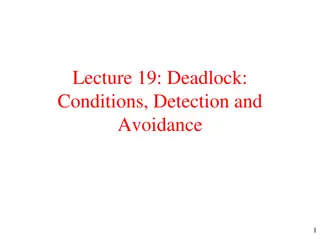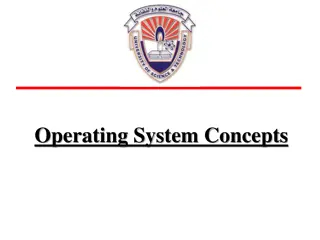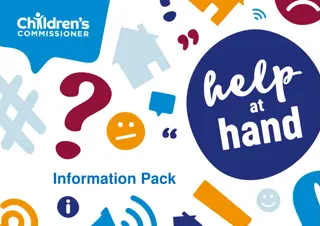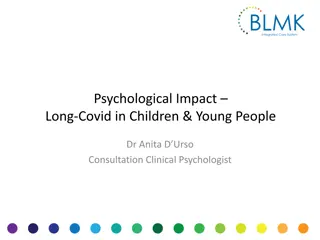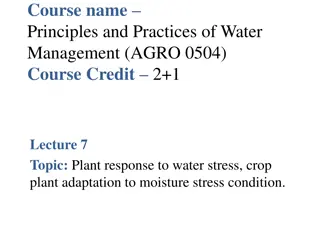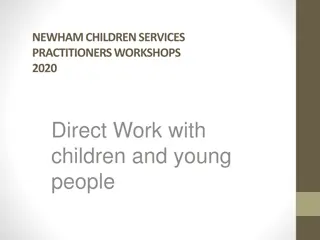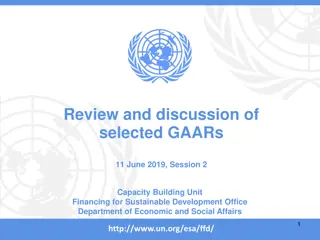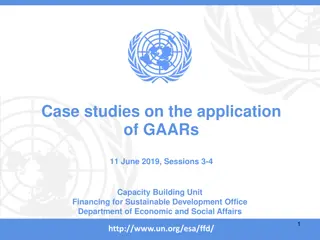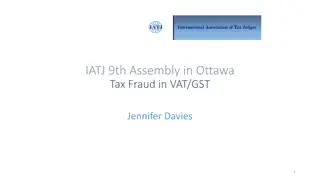Understanding Emotionally Based School Avoidance in Children and Young People
Emotionally Based School Avoidance (ESBA) is a common issue among children and young people, leading to school attendance concerns. This article sheds light on the diverse presentation of school avoidant behaviors, effective strategies for addressing them, and the prevalence of anxiety and stress as primary reasons for non-attendance. It also emphasizes the importance of collaboration between parents, caregivers, and schools to prevent prolonged periods of absenteeism due to school refusal. Various terms such as Chronic School Absence, School Refusal, and Truancy are discussed in relation to ESBA, highlighting the need for early intervention and support in managing these challenges.
Download Presentation

Please find below an Image/Link to download the presentation.
The content on the website is provided AS IS for your information and personal use only. It may not be sold, licensed, or shared on other websites without obtaining consent from the author. Download presentation by click this link. If you encounter any issues during the download, it is possible that the publisher has removed the file from their server.
E N D
Presentation Transcript
Emotionally Based School Avoidance Chris Atherton Angela Merrylees Monday 23rdAugust A
In the next hour we hope to Give an overview of Emotionally Based School Avoidance and it s many other names Gather your views on what is happening in your establishment: what works and what is challenging? Share strategies and support approaches across the group A
Healthier Minds Data so far 76 (27%) referrals for YP who have school attendance issues/concerns. 37% are 15 y/o 33% have an ASN 38% main reason (code) is anxiety/stress, 17% for low mood (including general, depression and suicide ideation)
School Avoidant Behaviours School avoidant behaviours are very common in children and young people Diverse in their presentation Visible and familiar: demonstrative behaviours e.g. separation anxiety persistent late-coming leaving the school building patterns of absence around trigger points (e.g. transitions, specific classes) Subtle: regular periods of self-certified absence any others?
School Avoidant Behaviours Many of these are addressed by effective parenting strategies Some through collaboration, between parents / carers and school - effective monitoring and support procedures. In some cases, these behaviours can develop into severe and prolonged periods of non-attendance that become deeply problematic.
Anxiety Based School Avoidance Chronic School Absence Persistent School Absence School Disengagement School Refusal School Refusal Behaviour School Phobia School Attendance Problems Truancy C
If the list is endless, how do you decide? C
Attendance Matters: A Practitioners Guide for Responding to School Avoidant Behaviours in East Renfrewshire (in Draft) Emotionally Based School Avoidance (EBSA) A pattern of school avoidant behaviours indicating that a child or young person is not attending school due to underlying emotional reasons. These reasons can be due to factors within and out-with the school environment. C
Risks Where sustained over a long period of time, EBSA can have a significant and detrimental impact on the child or young person s: Learning Social development Emotional regulation EBSA is closely associated with poorer short and long term outcomes, including: Relationship difficulty Difficulty mastering emotions in challenging situations Difficulty sustaining positive destinations such as further education, employment or training Increased likelihood of poor mental wellbeing (Kearney and Albano, 2018)
Contributing Factors/Motivating Conditions Child- specific factors Factors at school Factors at home ESBA Systemic Factors C
What is currently working well in your establishment to support children and young people with EBSA? Break Out rooms Professional Dialogue Share your thoughts, ideas and questions C
Break out room discussion points What are the motivating conditions in your school/setting/context? What are the challenges in relation to ESBA? What works well: what strategies, supports or approaches do you feel have had an impact? C
Motivating Conditions There are some patterns which are worth considering where children and young people may be more vulnerable. These include children and young people who have: anxiety low mood emotional lability neurodevelopmental differences such as an autistic spectrum condition, dyslexia, or significant learning needs experienced significant trauma responsibilities as young carers However, each case of school avoidance needs to be assessed in order to identify and address the unique factors that are contributing to the behaviour
An inclusive, welcoming environment that nurtures and which celebrates diversity Proactive Whole School Characteristics Commitment to understanding, supporting and addressing the developmental, learning, environmental and psychological factors that contribute to emotionally based school avoidance Positive, solution focussed interactions between all connected within the school that are characterised by respect, empathy, a non-judgemental stance, and a genuine commitment to both listen and help.
Proactive Whole School Characteristics An environment where people model and talk about the skills that build resilience, including emotional regulation, impulse control, the ability to reach out when help is needed, to focus on activities that individuals are good at (self-efficacy), to have realistic optimism about the future, and good causal analysis over when things go wrong and how to resolve or recover from them. Universally high level of staff knowledge, skill and ownership in supporting children and young people with additional support needs Emotional literacy, resilience and mental wellbeing featuring strongly within curricular experiences.
Ensuring that every child and young person has at least one key adult in their school life who demonstrates unconditional positive regard for them even when they are struggling. High expectations and standards of behaviour, with measured and respectful approaches to supporting those with behaviours that challenge and those who have experienced trauma Disciplinary management that is relationship driven and characterised by restorative approaches and natural consequences, avoiding punishment and shaming, such as making public examples of young people and egregious demonstration of power and control Proactive Whole School Characteristics
Proactive Whole School Characteristics An expectation that class teachers take the lead in developing relationships with the most vulnerable children and young people calls for support to include rather than withdraw children and young people from class Individual school departments each taking ownership for their inclusivity, the level of differentiation they can provide and attendance patterns within their subject, with appropriate support and challenge from the leadership team.
Identification, Assessment and Intervention
Age Related Patterns Ages 5 11 Children will tend to refuse school due to negative affectivity or for attention Ages 12-17 Young people will tend to refuse school to escape social or evaluative situations and or obtain tangible rewards outside of school Kearney and Albano (2018)
Early identification, assessment and response is key. Initial threshold for concern is two weeks Monitoring and checking in with parents is often best through the very early stages parental empowerment to address the situation is very important, however adaptations should still be considered early on by the school to alleviate stressors that will undermine the parents' efforts (e.g. being challenged for timekeeping, attending to smaller details like uniform policy compliance, deadlines for homework, upcoming assessments etc.) Initiating contact and developing a relationship with the parents is critical. Creating an alliance base on honest, empathy and respect will help in times ahead if things get particularly stressful. If the parent is struggling and or feeling judged / blamed, the possibility of splitting between home and school is strengthened (parents blame the school, school blame the parents the stalemate in which everyone loses, especially the young person). Early Identification
Early Intervention Guiding principles Support parents and the child / young person to engage with all relevant appointments with school and multi- agency partners where appropriate Support the parents to implement a school day within the home (no access to phones / tv. Boredom is an effective strategy in itself. Encourage school preparatory behaviours include morning routines, breaks, lunch and wearing of school uniform, even when home. Ensure academic work is made available for completion at home when the child / young person doesn t make it into school
Discourage peer contact out with school. If peers are a motivator, making in school attendance the easiest way to feel included can be a strong influence and an effective strategy. Early Intervention Guiding Principles If the young person can link with their peers too easily when they are avoiding school, where is the motivation to attend? (In some circumstances this can lead to isolation if ESBA continues over a longer period of time and needs to be carefully considered e.g. social phobia cases that aren t necessarily school specific). Maintain accurate records and monitor attendance patterns, share these with parents, and look for patterns of success and failure in attendance.
Examining the impact of contributing factors Don t get trapped - too easy to point to ineffective parenting - even where this is a valid factor, it is very difficult to influence and change, especially when things are entrenched (this doesn t mean we don t try to help and support change!) What are the contributing factors? What are the dominant factors?
Developmental acquiring a good understanding of the young persons growth and development e.g. their journey with their family, their friends, their experience of educational environments, and any additional support needs arising from developmental or neurodevelopmental differences that they may have (e.g. physical, sensory, social communication, learning differences etc.) Relational examining relationships the child / young person has with peers and adults at home and in the school, and also the relationship between parents /carers and key members of school staff Effective Assessment and Intervention Interactional acknowledging that factors which can be considered within-child (e.g. anxiety, low mood, social communication differences) only become problematic as a result of the individuals experience of their environment and their interactions within that e.g. through people, subjects places and rules / expectations. Functional developing a more forensic understanding of what is strengthening the school avoidant behaviours and what is weakening the desire to attend school (the push and pull factors) Targeted Holistic wellbeing assessment that is ecological and contextual taking account of home, school and community factors (a robust GIRFEC approach) that leads to clearly identified plans that minimise risks and maximise opportunities to change the course of the child / young person s journey.
Contextual Factors Contextual information guides the scope, pace and length of the intervention Child-related Parent-related Family-related Peer-related School-related Community-related Kearney and Albano (2018)
Functional Analysis What is the problematic behaviour? What is maintaining the behaviour? What is the behaviour trying to achieve? Effective monitoring of attendance and late coming will give insight: Examine total absences from school, whether authorised and explained or not Look for patterns Parental acquiescence Family transitions School based threats Social isolation Difficulties with academic work Kearney and Albano (2018)
Direct Functional Assessment The School Refusal Assessment Scale (Revised) by Kearney and Albano (2018) supports practitioners to identify which of these four common functions is most dominant: To avoid school-related objects and situations (stimuli) that provoke negative affectivity (symptoms of dread, anxiety, depression, and somatic complaints) To escape aversive social and or evaluative situations at school To receive or pursue attention from significant others outside of school To pursue tangible rewards outside of school
Other Examples of Direct Assessment Anxiety (e.g. Spence) Academic self concept (e.g. Reading self concept scale, Motivation for Reading Questionnaire) Educational assessment (e.g. WIAT) Resilience assessment (e.g. Resiliency Scales for Children and Adolescents)
Intervention Guiding Principles For plans of reintegration, target areas of the school day that the young person is most willing to attend, focussing on their strengths and areas of interests, their peer relationships, and their relationships with key staff members. Create a clear plan and stick to it. Outline a clear strategy and timeline of graded exposure / reintegration Support parents to encourage and make opportunities for in school attendance every single day, even if it is for the last few minutes of the day or in the building after school is finished. Never minimise any successful step over the threshold of the school building. Praise and build on the success of small positive steps, make the next step only slightly more challenging
Targets: Get up and ready for school by 9am each morning. Drive to school with family members then come back home if you want to. Log on to Google Classroom and check work for 1 subject per day. Tick 8th-11th June Week 1: Any other achievements 14th 18th June Week 2: Continue to get up and ready for school by 9am each morning. Continue to drive to school with family members then come back home if you want to. If at home, continue to Google Classroom and check work for 1 subject per day. Travel in the car to the school on one day to collect some work from Mr Smith, from the car park. Any other achievements 21st - 25th June Week 3: Continue to get up and ready for school by 9am each morning. Continue to drive to school with family members then come back home if you want to. If at home, continue to Google Classroom and check work for 1 subject per day. Travel in the car to the school on one day to collect some work from Mr Smith, from the car park. Write a list of school achievements over the past year and email it to Mr Smith. Any other achievements A
Intervention Guiding Principles Encourage school attendance at every point of vulnerability for example, if the young person is experiencing mild illness or headaches these can be assessed in school (coming in and being sent home by school staff is better than potentially reinforcing this as a strategy for avoidance). Be transparent with parents about why this should be a collaborative target. Maintain daily records of success and challenge within the school day when the young person makes it in. Involve them in this as a way to talk over what they have achieved as well as what they need more support or adaptation with. (This level of maintenance is crucial and often overlooked when a child comes in as that is what s expected ). Agree clear, natural consequences for attendance and non attendance, making use of the young person s interests as motivational tools
Intervention Guiding Principles Help the parent to identify their own network of support from family members and friends who may be able to help in different ways (e.g. multiple children getting to school, job related factors that make certain points more difficult, positive role models that the young person admires). Develop parent and pupil resources to support what your school is trying to achieve so that they can see the approach is standard practice and evidence based help people to feel less isolated and less judged through the language that is used. Offer psychoeducational self help resources to support better mental wellbeing (e.g. Healthier Minds)
Intervention Guiding Principles Where possible, be solution focussed and try and reduce practical barriers (e.g. temporary transport issues, worries about taking a particular route to school) that present as further obstacles. Be sure to rule out actual school based threats as a cause of the behaviour (e.g. peer relationship threats or difficulties, social media).
Severe cases Prolonged non attendance at school, where a young person has been absent for over 1 year, is extremely difficult to unpick and change. Patterns of behaviour are entrenched Underlying emotional needs are more difficult to address and support in context Often very low willingness or capacity to change the dynamics of critical relationship at home Again, this doesn t mean we don t try to support change in these areas However, by this stage more emphasis needs to be placed on supporting the young person to access their education to achieve and attain as best they can so that they are as ready, as is possible in the circumstances, to access further education, training or employment.
In Summary Early Intervention Planning with the child/young person, their family, school staff and partners Individualised assessment and intervention Smart Outcomes: Universal, Targeted or Individual Connectedness and Relationships Small Steps (sometimes tiny) E.g. Gradual Exposure: treat each success as a win to be developed and progressed. Flexibility A
Chris.Atherton@eastrenfrewshire.gov.uk Angela.Merrylees@eastrenfrewshire.gov.uk https://blogs.glowscotland.org.uk/er/PsychologicalService/school- staff/building-resilience/healthier-minds/ https://youtu.be/1s8UxUxga78 A










